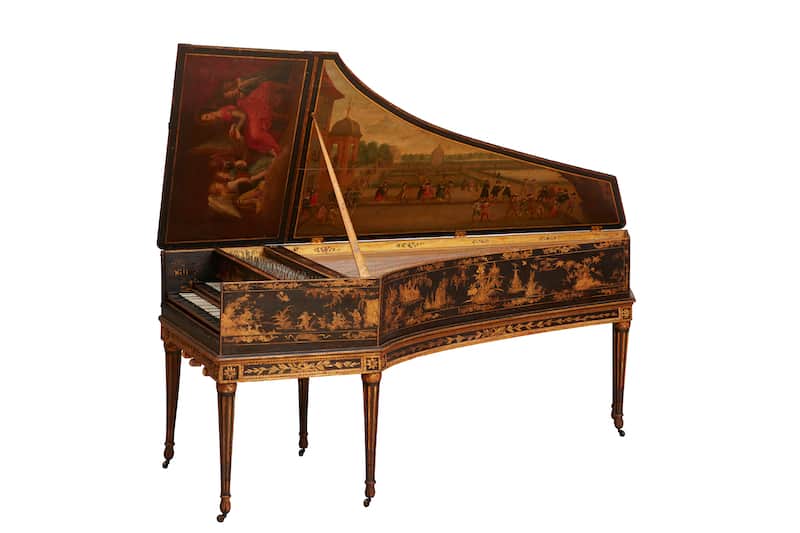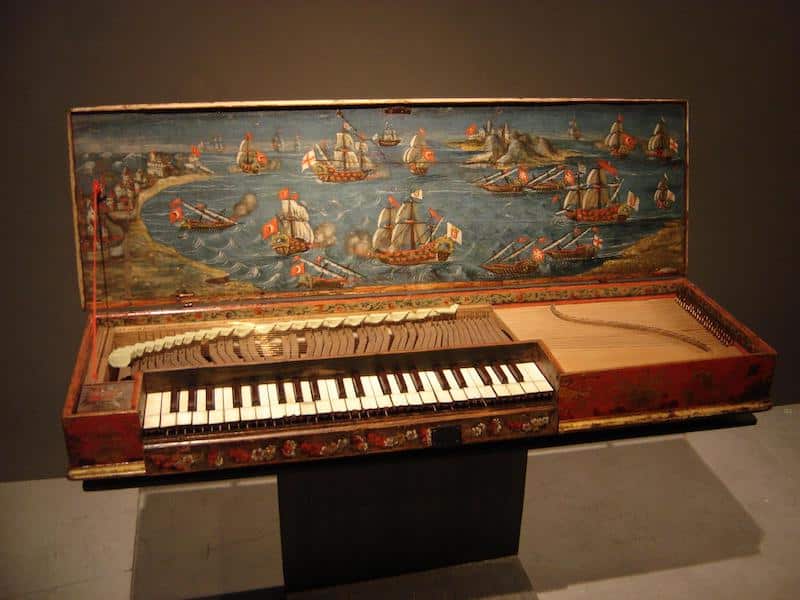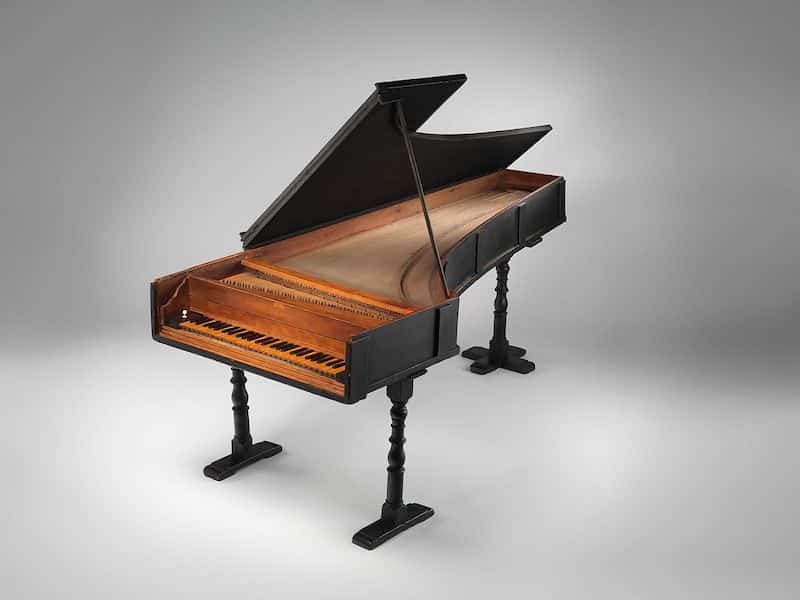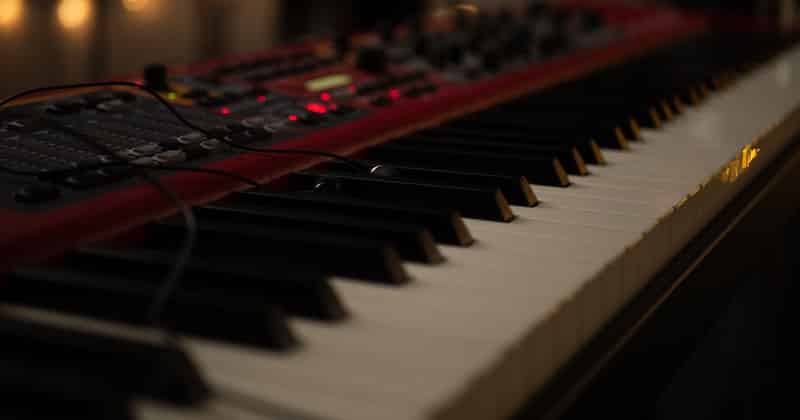When asked what type of instrument a piano is, most novice musicians will start to answer and then realize…they really do not know the answer! It’s not a string instrument, like a guitar or violin, right? Even though it somewhat resembles instruments such as xylophones, it can’t possibly be a percussion instrument, can it? The surprising fact is that the piano is both a string and a percussion instrument! As you move through the evolution of the piano below, you will learn how these string and percussion elements came together to create the unique sound of the first modern piano.
The Piano’s Predecessors
The Monochord
The ancestry of the piano begins in the year 500 BC, when the Greeks invented the first Monochord.
Monochord literally means one chord, and this instrument consisted of one metal string stretched tightly over a hollow body of wood called a resonator table..
The string was long enough to be divided into different sections and placed over the body in various ways so that the musician could create different notes and multiple octaves.
The monochord was used for music sometimes, but was primarily used for a variety of other tasks.
It was a useful tool for tuning other instruments all the way through the 19th century.
The monochord made a great teaching tool, as it was the first instrument to lay out chords in such a visible way.
It also helped singers learn pitch.
The Polychord
Whereas mono means one, poly means many.
The Polychord refers to a range of instruments that came from a desire to more efficiently achieve the range versatility made possible by the monochord.
The two polychords that most greatly influenced the piano we know today were the harpsichord and the clavichord.
Both resembled the modern day piano in looks.
True to the era in which they were created, these instruments were typically adorned with ornate carvings and colorful paintings.
The Harpsichord

The Harpsichord came on the scene in the 14th century.
It was a full plucked instrument, meaning it created sound through the plucking of strings by quills that are connected to the keys that the player presses.
Closer to the 15th century, the clavichord was invented to resolve some of the weaknesses of the harpsichord.
The Clavichord

The clavichord included hammers that also struck the strings; this is where the percussion aspect of the piano was born.
It also provided the ability for the strings to vibrate for as long as the keys were depressed.
The harpsichord plucked each string once, and that was it, producing a sound very limited in volume and length.
The clavichord afforded the player a novel range of sound and therefore the artistic expression so desired during its Romantic era existence.
Cristofori: The Inventor of the First Pianoforte

Even the clavichord still lacked the level of volume that musicians craved during the Romantic era and beyond.
Right around the turn of the 18th century, this yearning is what drove Bartolomeo Cristofori to invent what we now consider to be the first of the pianos we know today, the pianoforte.
In Italian, piano means soft, and forte means loud which are how we describe dynamics in music.
It’s as simple as that, the pianoforte became a unique stringed percussion instrument with the capability to play from soft to loud and back again with just the simplest change in pressure of the fingers of the player on the keys!
Cristofori was already well known as a maker of harpsichords and other predecessors of the pianoforte.
Less than 20 years before the invention of the pianoforte, Cristofori was appointed Grand Prince Ferdinando de’ Medici, by the Court of Florence, to care for all of its musical instruments.
It is in the notes of a Florentine musician that we have a written record of Cristofori’s first pianoforte.
You can still see three of Cristofori’s pianofortes that all date within the 1720s with your own eyes today; one at the Metropolitan Museum of Art in New York City, one at the Museo Strumenti Musicali in Rome, and one at the Musikinstrumenten-Museum of Leipzig University.

The pivotal piece that made the pianoforte a little less piano and a little more forte, was an escapement mechanism.
This mechanism frees the hammer from the string right after pressing the key, removing any dampening of sound by allowing the strings to vibrate longer.
The stings were also thicker and more tightly strung than in previous instruments.
The only additions that have been made to set the modern grand piano apart from the pianoforte are an additional 34 keys for a total of 88, as well as even thicker strings and harder hammers.
How the Piano Gained Popularity
At the time of its creation, the pianoforte was very expensive and therefore primarily utilized by Italian royalty.
It was also primarily considered a feminine instrument.
Women who played piano were considered to be more desirable candidates for marriage on account of its status symbol.
Very progressive for its time, female pianists inspired many pieces by famous composers such as Beethhoven, Mozart, and Hayden.
More true to its time, professional concert pianists were typically men.
It was catching the interest of these famous classical composers that started the piano down a path of global popularity.
Due to the sound quality improvements of the fortepiano, the instrument became suitable for orchestral and other concert ensemble play in addition to solo work.
It didn’t take long for middle class families to save up for their own pianos.
This is partly because playing and teaching music were typically middle-class careers.
The development of the less grand upright piano in the 1800s made this instrument more accessible, as well.
Technological Development of the Piano
Starting at the dawn of the 20th century, mechanical and technological additions to the piano jump started its accessibility, affordability, and popularity.
These developments also allowed allowed the piano to diversify along with the Modern era of music.
Below we will discuss the three most well known piano cousins.
Player Pianos
Even people who had no interest or ability to play the piano began to crave its unique sound.
In 1896, Edwin S. Votey granted their wishes by inventing the Pianola – the first player piano.
Contrary to its name, the player piano has no player at all, but rather plays itself!
The original Pianolas worked through a series of pedal-controlled vacuums.
They evolved to include elements of electricity.
Keyboards, Synthesizers, and Digital Pianos

Electricity and technology opened up a whole new world of possibilities for piano players and the music industry.
During World War II, American pianist Harold Rhodes invented the electric keyboard.
This smaller electric version of the piano created the unique piano sound that quickly earned a starring role in jazz and pop music.
Its ability to be connected to sound amplification equipment made it possible for electronic piano parts to debut in larger concert settings.
Shortly after the invention of the keyboard, the year 1955 brought the invention of the synthesizer.
The synthesizer looks a lot like the keyboard fused with the dials and buttons of a sound board, which is essentially what it is!
It is played with keys like the keyboard but has the technological capability to reproduce sounds not only of a piano but also a plethora of other instruments.
Invented by American acoustical engineers Harry Olson and Herbert Belar.
In the 1970s, the idea struck musicians to combine the versatility of the electronic keyboard with the traditional sound of the piano.
The final product is called the digital piano.
It was formally patented in New York by Wil Decker in the early 1980s.
Conclusion
To this day, the piano is still one of the most popular instruments that children and new musicians learn.
It is simpler than other instruments to learn because the notes are laid out in a linear fashion and the mechanisms of the instrument itself handle much of the basic technique.
It is one of the easiest instruments to play solo, but its versatility and unique sound also add indescribable value to everything from classical orchestral music to pop hits to movie scores.
Combined with its dynamic historical evolution, it is safe to assume that the piano will play a starring role in music for years to come.
